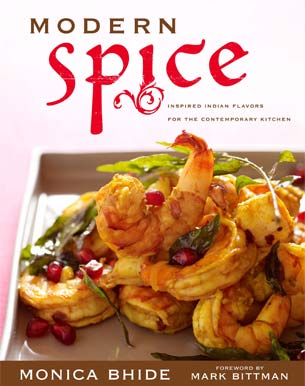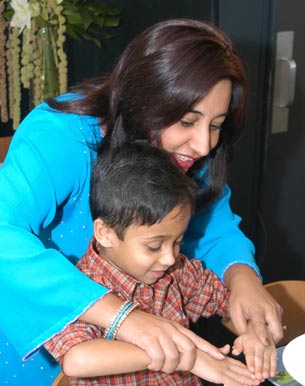
Monica Bhide's favourite story is located in the kitchen.
'Honey,' says a husband to his wife, 'I love the way you bake ham, but why do you cut the end off? That is my most favourite part.'
'My mother cooks it this way,' she replies. 'It is tradition.'
Later, she calls her mother. 'Mom, why do we cut off the end of the ham?'
The mother does not know, so she calls her mother-in-law. 'Why do we cut the ends off a ham, Mama?'
'Ah, that,' says the 100-year-old mother-in-law. 'When I first cooked a ham, I didn't have a pan big enough.'
The author of the well-received cookbook Modern Spice -- Inspired Indian Flavors for the Contemporary Kitchen says she is reminded of this story, which she first heard many years ago, whenever talk veers around to 'authentic' Indian dishes.
'It reminds me that just because we have always done things in one way, it does not make it the only way to do something, be it in the Indian kitchen or Chinese,' says Bhide, an engineer turned cooking instructor and now author featured on National Public Radio.
'People forget that from time immemorial, Indian cuisine has been changing,' says Bhide, whose articles on Indian food are featured in mainstream publications, and who has her own food blog on the Washington Post site besides her own site at monikabhide.com. 'Our cuisine has not only been shaped by our own imaginations and experiments over the centuries but also by what the Mughals brought to India.'
"If Fennel-and-Chilly-Crusted Tilapia and basmati rice with pine nuts and mint, accompanied by Guava Bellini, does not sound Indian to you, think again!" she says. "Indian food has come a long way from the same old world of Mango Lassis and Tandoori Chicken."
 |
Her book reflects the attitude of younger Indians not only in America and Canada but worldwide. "There are a lot of myths surrounding Indian cooking," she says. "Many believe most Indians are vegetarians. And it is simply not true."
A food writer recently told her that Swami Vivekananda continued eating fish even after he became a monk. "And then there are those who believe that every Indian dish has to be fiery. And, of course, the myth that all Indian cooking is difficult and time consuming."
Many of the recipes she offers require 20 minutes or less, and there are some that, if you use shop-bought ingredients like garlic-ginger paste, can be made in about 12 minutes.
'The biggest myth of all has to be that urban, middle-class Indians -- in the United States and India -- don't use any packaged stuff,' she writes. She has come across celebrated chefs who use spice mixes such as chaat masala or sambhar powder. She personally cannot bring herself to buy garam masala, preferring to make her own, but she is not against the quality chutneys and pastes sold in the markets. 'While it is rewarding to create your own spice mixes, fresh homemade cheese, and chutneys, it does require time and patience.'
| Mango-Almond Chutney The key to the success of the recipe is the high quality of the mangoes, Monica Bhide says. They should be ripe but not too ripe. She does not use canned mangoes because they do not give the chutney a good texture. What if you cannot find fresh mangoes? In that case drain the can well, leave out the sugar from the recipe and reduce the cooking time, she says. Preparation, cooking time: 40 minutes Yield: Two cups Ingredients
Method Cool, then transfer to a covered jar. Refrigerate until needed. |

Bhide, who has two masters' degrees from American universities in addition to an engineering degree from India, has lived in the Washington DC area for 15 years. The mother of two pre-teen boys has, in her new book, distilled some of her best recipes, tried and perfected over many years.
"As a generation of modern Indians, we are changing everything, not only here but also in India," she says. "We respect the tradition and traditional recipes, but we are giving them a new spin. And this is often done very spontaneously."
Her book, published by Simon & Schuster in America, carries a foreword by cookbook writer Mark Bittman, who praises Bhide's sense of adventure and her pursuit of imaginatively conceived dishes.
'Monica Bhide is a mistress of spices who uses them like enchanting spells,' writes best-selling author and chef Art Smith (Back to the Table). 'Her recipes will take you to distant lands but bring you right back home with their taste and ease!'
The more tradition-oriented of her readers wonder at her avoidance of the foods Indians have grown up loving. Why, someone asked her recently, is there no recipe for Mango Lassi in her book?
"There must be over 200 books (including my previous book) with Mango Lassi and Chicken Tikka Masala recipes," she says. "Instead of Chicken Tikka, I offer a recipe for chicken simmered in fresh cilantro and mint. The recipes in Modern Spice are not traditional Indian recipes, although they have roots in tradition and are inspired by it. And that is why I offer recipes for such dishes as Pomegranate Shrimp, Paneer and Fig Pizza and Indian Chicken Wings."
People do not realise that each region, each district in India offers variations of the same base recipe. "I have written in my book how hard it is to find 'authentic' recipes, as the definition authentic is different from state to state, city to city, and even household to household," she says.
"That reminds me of my grandmother's dal. It was her version of a traditional Punjabi recipe. Now, the dal my mother-in-law, who is a Maratha, makes is very different. Both traditions are valid, of course, and both recipes produce delicious dal."
Bhide, the eldest of two daughters, was fascinated by cooking right from childhood on. "My grandmother in Delhi used to complain, whenever we visited her, that I was spending too much in the kitchen learning from the servants and that I wasn't spending much time with her."
She also acknowledges a debt to her father D N Saigal. "He was hugely fascinated by spices, food and cooking. He was an engineer but he had interest in fine arts, in food, and travel. When we lived in Bahrain, he traveled a lot on work across the globe, and he would bring home exotic food," she recalls.
Though she was drawn to cooking and writing from an early age, she could not contemplate opting for liberal studies or joining a culinary institute -- both options considered, in the traditional Indian mindset, as being too 'risky'. Her father, she recalls, told her she should have a 'real education and get a real job.'
 |
Her personal epiphany came five years ago, when a close friend died in a freak accident. She was in her early 40s at the time, and the sudden encounter with unexpected death made Bhide think about her priorities. She was doing well in a 9 to 5 job, but there was no real joy, no real challenge in what she was doing. She quit the job, and then told her husband. "He knew what I wanted," she says.
It took her a few months of downtime to organise, to think of starting cooking classes.
| Green Chutney Chicken Preparation, cooking time: 25 minutes Serves: 4 Ingredients
Method |

Meanwhile, she was also writing to newsletters even though they paid nothing. In the process, she began building a fan club and caught the attention of New York Times columnist and best-selling food writer Bittman.
Life changed; Bhide found herself doing what she liked, and increasingly in a position to make a living at it. The passion for food, that goes more than mere recipes, drives her book, which offers more than the usual recipes and food-related stories. It also serves as a travelogue, for she writes about her experiences growing up in Bahrain and her search for good local food when she visited Dubai not long ago.
The secret behind her cooking, she says, is condensed in one word: 'Spontaneity -- also known to my friends as my lack of patience,' she quips on her site. 'When I cook, I love to play with my ingredients. I mix flavors, add different spices. I am not afraid of trying new things.
'Cooking dates and figs together, for instance: I have said in interviews that the kitchen is not the place to be over-analytical. Just put things together that you like -- simplicity works best. Then, as you go along and get more experienced, begin adding more complex ingredients and you will be creating superb dishes in no time.'
 |
From that, stems the lesson she offers new cooks. "Do not be afraid. Keep things simple. And be resourceful in fixing things if something goes wrong. Feel the spices, learn about them and see how the same spices taste different if cooked differently."
| Mint-Cilantro Pomegranate Chutney Preparation: 10 minutes Yield: 2 cups Ingredients
Method |